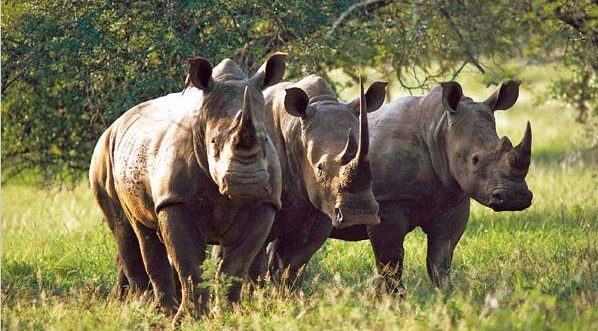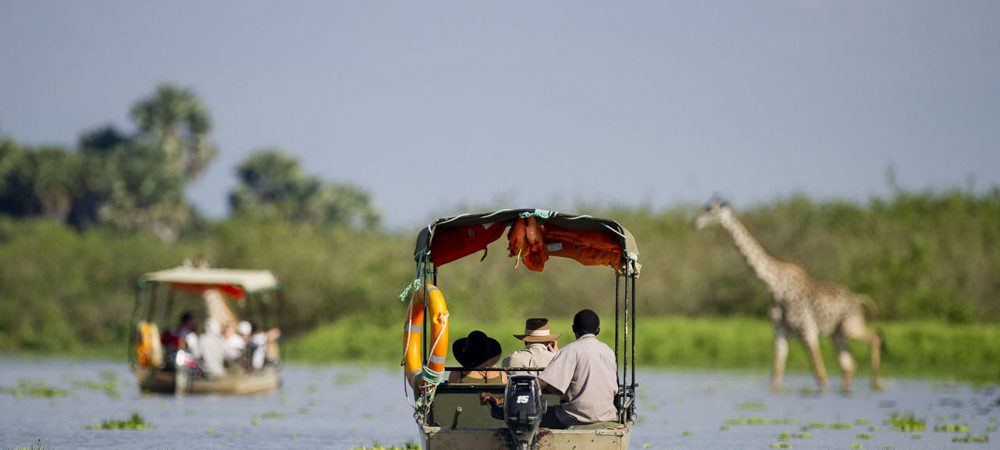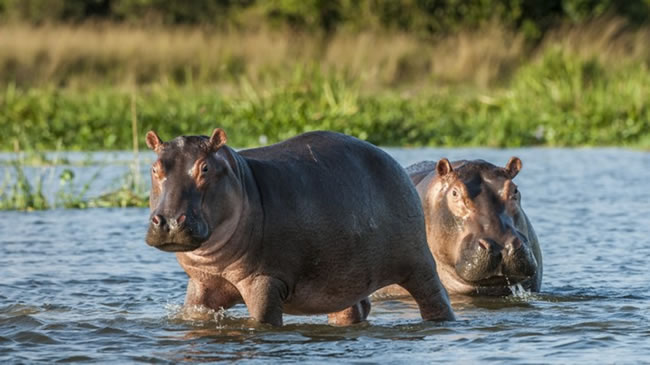Arusha National Park, located northeast of Arusha, is the most accessible national park on Tanzania's…

Selous game reserve
Selous wildlife reserve Tanzania is located between 130 and 500 kilometers south-west of Dar es Salaam in the Miombo woodlands. In the northwest, Selous game reserve shares borders with Mikumi national park, Udzungwa Mountains national park, and Kilombero game-controlled area.
Selous national park is a UNESCO World Heritage site that encompasses an area of 50,000 square kilometers. The park’s territory consists of a variety of tenure and vegetation zones. The central region of the Selous game reserve is characterized by a flat, undulating landscape with alluvial valleys, protruding inselbergs, and thickets and dense vegetation. The south region is forested, mountainous, and rugged, while the south western region contains the 1300 meter-high Mbarika Mountains. The west region of Selous game reserve is mountainous and forested, with wet lowlands in between, while the east and north are tree grasslands that are flooded by river Rufji during the rainy season.
Selous game reserve is home to a diversity of animals and birds. It is also home to the largest population of elephants on the African continent with 110,000 individuals, as well as the largest population of lions on the African continent. Other animals found in Selous game reserve are buffaloes, zebras, impalas, giraffes, greater kudus, waterbucks, bushbucks, Lichtenstein’s hartebeest, elands, African wild dogs, brindled gnu, Nyasaland gnu, sable antelopes, warthogs, leopards, spotted hyenas, and crocodiles.
These lakes include Tagalala, Mzizimia, Siwandu, Manze, and Nzelekela. The Selous game reserve is comprised of lakes that are home to fauna and bird species. Also, animals are drawn to the Rufji River and its tributaries, particularly during the dry season, when they come to consume water.
The Selous game reserve is one of the most well-known birding habitats and destinations in Tanzania; it is a magnificent habitat for 400 species of birds that reside primarily on the banks of the lakes and River Rufji channel. The migratory bird population in Selous game reserve includes spur-winged lapwing, African wattled lapwing, white-fronted bee-eater, Pel’s fishing owl, African spoonbill, common-white-headed vulture, pearl-spotted owlet, white-headed Lapwing, Bohm’s bee-eater, yellow-billed stork, thick-billed cuckoo, white-backed night heron, carmine bee-
The background of Selous wildlife reserve
Selous game reserve was designated a protected area for the first time in 1896 on the orders of Hermann Von Wissmann, the German Governor of Tanganyika, the present-day Tanzania. In 1905, the area was declared a hunting reserve, and in 1922, the reserve’s area was expanded. The territory was named Selous game reserve after the British explorer Fredrick Courteney Selous, who was killed during the First World War and whose grave can be visited as a monument in the reserve. In 2005, the Selous game reserve was designated as a lion conservation unit, after the reserve’s boundaries had been expanded to their current extent by 1975. The reserve was added to the list of World Heritage in Danger in 2014, and this decision was reaffirmed in 2017 due to the increasing poaching and uranium extraction in the reserve’s southern region.
Safari activities in Selous game reserve
Game viewing
The Selous game reserve is home to a variety of animal species, including the largest population of the rare African wild dog, which can be observed during this safari adventure. From the comfort of your 4X4 vehicle you will have an opportunity to spot animals like zebras, impalas, giraffes, greater kudus, waterbucks, bushbucks, Lichtenstein’s hartebeest, elands, African wild dogs, brindled gnu, Nyasaland gnu, sable antelopes, warthogs, leopards, spotted hyenas, crocodiles and many more. The banks of the river Rufji are frequented by a vast number of animals coming to drink water, making for superb game viewing.
Birding
Selous game reserve is one of the best places to visit in Tanzania for a memorable birdwatching safari, as it is home to over 440 bird species that inhabit the islands, channels, sandbanks of river Rufji, and lagoons. Due to the location of the Selous game reserve in the migratory path of avian species from Europe and northern Africa, the reserve begins to receive migratory bird species in April. Birding in Selous game reserve offers sights of bird species like African wattled lapwing, white-fronted bee-eater, Pel’s fishing owl, African spoonbill, common-white headed vulture, pearl-spotted owlet, white-headed Lapwing, Bohm’s bee-eater, yellow-billed stork, thick-billed cuckoo, white-backed night heron, carmine bee-eater, rock pratincole, giant kingfishers, spur-winged plovers and many more.
Walking excursions
Walking safaris in Selous game reserve are conducted along the magnificent river Rufji on the sandbanks and through the riverine forests on the river’s banks; this experience provides the ideal chance to explore Selous game reserve to the utmost. Expect to see lions, giraffes, waterbucks, elephants, and many more as they graze and hippos, crocodiles as they play in the waters of River Rufji. Walking safaris are conducted in groups of no more than six people under the supervision of an experienced armed safari guide.
Boat excursions
Selous game reserve is one of the few national parks in Tanzania where visitors can observe wildlife from the water; Selous River camp offers boat safaris on River Rufji and Lake Tagalala. Short boat safaris last two hours and are offered twice a day, from 7 a.m. to 9 a.m. and from 4 p.m. to 6 p.m., while full-day boat safaris last eight hours. Full day boat safaris are offered from 10 a.m. to 6 p.m. and last an entire day. Boat safaris provide the ideal opportunity to view animals such as crocodiles, hippos, lions, giraffes, impalas, and waterbucks congregating at water bodies to drink.

Fishing excursionsSelous game reserve is an excellent location for fishing safaris, as the reserve is traversed by the Rufji River, which is home to numerous fish species that are captured during fishing safaris. On fishing safaris, you may capture Rufji Tilapia, Oreochromis Urolepis elephant fish, Marmyrus Longirostris, catfish species such as Heterobrancus catfish, and many others. In order to reach the fishing locations, fishing safaris incorporate a boat cruise.
Cultural excursions
A safari in Selous game reserve is not complete without a visit to the Mloka village located near the park and downstream of Selous River camp. A cultural tour offers tourists the chance to engage in cultural and local activities, such as meeting the locals, visiting primary schools and markets, and more. Long or short cultural excursions are available to accommodate the preferences and available time of tourists.
How to get to Selous game reserve
Selous game reserve is accessible by road, air, and rail, all of which are reasonably priced for safari travelers. From Dar es Salaam to Mtemere gate via Kibiti and Mloka, the Selous game reserve is 240 kilometers away and can be reached by car in approximately six hours. By train, the Selous game reserve can be reached in 4-5 hours; the train pauses in Matambwe before connecting to the park. Selous Game Reserve is accessible via daily scheduled chartered aircraft from Arusha and Dar es Salaam to Selous game reserve. Domestic airlines such as Air Tanzania, Precision Air, Regional air, ZanAir, Safari Air Link, and Coastal Aviation offer these flights. Selous game reserve flights arrive at the Mtemere airstrip that serves the game reserve.
Where to stay in Selous game reserve
Sand river Selous, Jimbiza Lodge, Selous Kulinda camp, Selous Mbega Camp, Selous wilderness camp, Africa safari camp, Selous Ngalawa camp, Selous river camp, The Retreat, Roho ya Selous, Selous Serengeti camp, Mivumo River Lodge, and many others are among the numerous accommodation establishments established in Selous game reserve to provide tourists with a place to stay.



